Ad links added 10-23-17. See (brother) Fred's description of the trip: The Great 2001 Amazon Adventure. The road back home |
Ad links added 10-23-17. See (brother) Fred's description of the trip: The Great 2001 Amazon Adventure. The road back home |
What was my vulnerability, I was wondering, that made me so agreeable to my brother's (Fred's) entreaties to visit the Amazon with him? This thought was meandering around my mind as we were into our second hour of trekking through the Amazon rainforest. The temperature was somewhere in the mid-90s...the humidity probably was at about the same level...my safari shirt was soaked through with sweat...my bare arms, laden with sun block--sun block in the jungle?!, what was I thinking? -- were swarming with mosquitoes (at least, my malaria pill-popping was up to date)...our jungle guide spoke only Brazilian (in Brazil, they do not speak Portuguese, it's Brazilian, they say), so his homilies about the wonders of the friendly jungle were beyond our understanding...we were climbing a grade -- again!...and I had to pee. Is this what I bargained for? Yes! It was delicious. It was an adventure. It was real. It was consummately out of the ordinary. It was Amazonas, and I was there...living in it, breathing in it (albeit somewhat heavily), stomping in it, perspiring in it, hearing the caterwauling of the birds in it, on the lookout for killer ants in it, touching the barks of exotic trees in it, sniffing the leaves in it, even enjoying it. This, I thought, is not a vulnerability. It is a fortuitous gift. And then we came upon a rise, which revealed a surprisingly deep-blue-looking Negro River through the trees, our luxury yacht idly floating at the foot of the hill. I just had to make a record of some of these impressions. The counter attendants at Varig need to be better versed in English. I found it difficult to understand them. Their directions that the Manaus flight would board at 9:00 were off by more than a half-hour. No announcement called passengers to the gate at Miami Inter-national Airport. People just started shoving in when an attendant showed up at Gate 23. The "Elder Hostel" passengers offered quite a contrast to a bunch of teenagers (college students?) before boarding. Although service was prompt aboard the aircraft, instructions from the crew in English (via intercom) were difficult to understand, and always took second place to the Portuguese (Brazilian?) messages. The meals did not stick to the menu handed out. Before take-off we received a little plastic cup of juice and some crackers...then we waited over a hour after being airborne before a meal was served. And we were never presented with a "breakfast." Just another plastic cup of juice a few minutes before landing -- at 3:00 a.m.! The crew neglected to give to us (my brother and me), both bound for Manaus, entrance forms for Brazil. A young passenger went back to the aircraft to secure some forms for us as we waited in line after disembarking. Thank goodness for the transfer contact at the airport. Feeling tired and neglected by the customs crew was one thing. Waiting was another. Being greeted by a clean-shaven man holding a "GIELOW/ frederick" (sic) sign was a delight. The drive from the airport traveled empty roads, including a boulevard. What a surprise to see a possum cross at one point! The driver, Nacareno Pereira of the ARUAK VIAGENS & TURISMO, stopped the van for us to watch. Fred thought it looked like a little anteater, and so did I. The first wake-up call at the Hotel Tropical, which was requested for 9:00, came at 8:45 -- and was recorded: voice and music. Then, a live person called about 9:00 a.m. We figured it took 355 medium steps from our room to the dining room at the hotel. Thank heavens our bags were wheeled to our room upon our "late arrival." When I had to hurry back on Friday to grab my forgotten vitamins, I made it in 285 long -- almost jogging -- steps. Nice to see a pot of "porridge" for breakfast at the hotel buffet. Chicken franks, too. The zoo outside our hotel room window was stocked, surprisingly, with a number of animals and birds. Peccary, cappy bara, coati, jaguar, ocelot, macaws, toucans, parrots and several species of monkeys were in evidence. The monkeys used their tails as third arms -- hanging by them, clinging with them, advancing along the cage by using them to grab ahold. There's a flat, pad-like surface on the underside of the end of the tail (like a thumb), providing them better leverage. A few words about the atmosphere. It is dense, moist -- but not "sticky." Skies threatened, but no rain. Shops outside the hotel are mostly tacky, very small. Several were classier inside (perfumes, watches, jewelry like silver or tungsten wedding bands. I didn't know they made tungsten wedding bands). How do these shopkeepers make a living? An upscale shop along the lobby of the hotel revealed an attendant (?) performing a Bible reading each day we were there. An extensive luncheon buffet (in the dining room), included a whole fish (18-20 in.), meats, cheeses, salads, rolls, hot dishes (rice, beef rolls with bacon, chicken), potato-like dishes, plus three tables of desserts -- mostly pastries, and all rich-looking. "Eddy," our guide to the city, was supposed to meet us at 2:00 p.m.in the lobby of the hotel. He was late, sweating from having just finished another tour with Americans. He also was a blow-hard: limited information (some of it contradictory), repeated a lot, but unlimited self-assurance. We thought Eddy would be our driver -- but he was only our "guide." Another, clean-shaven young man, darker than Eddy, turned out to be our "wild" driver. He passed a bulbous, wide- body bus in front of the hotel with about two inches to spare on either side, so I figured he was competent behind the wheel. On the open road, which was nice to see in the daylight for the first time, he drove like a maniac: much too close to other vehicles, narrowly missing vehicles crossing in front of us, and coming very close to pedestrians -- all at an accelerated rate. Narrow streets alternated with boulevards to and from downtown Manaus. Most roads had little shops with ugly painted signs. But much high-rise construction was evident near the hotel...much of it with a view of the river, the Rio Negro. And many of these high-rises were in proximity to Ponta Negra (a bathing/entertainment beach). Manaus turns out to be a city that grew too fast. On our route to and from, no apparent neighborhoods with different characteristics --just many, many shops and eateries with little distinction or character. Eddy tells us the population is over two million (our advance brochures reported one million.) 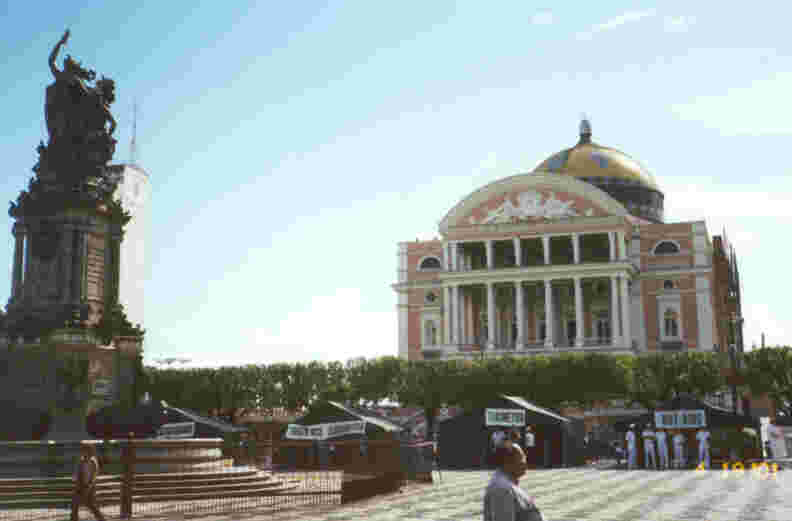 The Manaus Opera House begins its "season" shortly after our visit, according to someone on the yacht leg of our trip. Eddy said the Opera House was being renovated and would take two months--or weeks, he wasn't sure. We saw painters there, but not much else. A stage play's scenery was being worked out as we walked through. Three tiers of box seats, plus the main floor. Murals on the ceiling and walls, busts of composers on columns supporting the first level of boxes. The Manaus Opera House begins its "season" shortly after our visit, according to someone on the yacht leg of our trip. Eddy said the Opera House was being renovated and would take two months--or weeks, he wasn't sure. We saw painters there, but not much else. A stage play's scenery was being worked out as we walked through. Three tiers of box seats, plus the main floor. Murals on the ceiling and walls, busts of composers on columns supporting the first level of boxes.Eddy said the first production took place two weeks after the building was finished (?). The intermission room also displayed ornate appointments, with murals above and alongside. Much marble work, plus the customary (for Manaus) interspersing of light and dark wood flooring panels, signifying the confluence of the tan Amazon and black Negro waterways. (The Negro River is black because of its high pH factor--very acidic. High mineral content, many leaves decaying along the bottom--but not much sediment. The Amazon, though much colder, has more sediment and soil in suspension. Resultantly, there are more bugs along the Amazon, but not habitating the banks of the Negro.) There is no parking area around -- or near -- the Opera House. The brick road around the perimeter of the building is coated with indigenous rubber (blackened) to soften noise (says Eddy). During our visit, the Opera House was right in front of the sun -- not good for photos -- and a few blocks from the riverfront. No photos allowed inside with flash, and that's the only way one could capture the decorations of the interior. Across from the Opera House is a square with the Albertura dos Portos monument occupying its center. The Brazilian army band was blatantly exhibiting its bad musicianship at a corner of the square, attempting to draw people to a fair featuring social services: medical, psychological, day care, etc. Spectators seemed disinterested in the band (with good reason), and there weren't many visiting the displays in tents at the perimeter of the square. Of course, Eddy had to take us to a tourist trinket shop (post cards, stuffed piranhas and hundreds of scenes of the Opera House, plus the obligatory tee shirts). The Manaus land-bound market (not the famous floating market, which we never saw) is modeled after Les Halles in Paris. But the similarity ends there. It is hot, stuffy, and jammed with people--but not many buying much of anything. Many merchants sit (stand) amongst their wares with blank faces, sweating in the thick atmosphere. The market is full of stalls with grains and nuts in bulk, plus loads of trinket booths...and who-knows-how-many stuffed piranhas! The local folk we saw -- some Amazonians, some Brazilians, some mixed ("lattes" says Eddy) -- are generally either light complexioned, dark or in-between. The darkest, as we learned later, are from the interior: river dwellers, or those living in the rain forest. At the old customs house, a converted rubber baron mansion (three stories, with balconies and ornate staircases -- spiral ones, too), we saw hundreds of school kids. Nearly all children were in uniform: white top and dark blue pants -- shorts or trousers. The children milled about the house chattering, obviously excited. According to Eddy, the kids were public school children, not parochial (Catholic), on an outing to the house. There were guides with a number of the groups. In the courtyard, members of a genuine Amazon tribe were performing ritual dances: mostly movements back and forth -- in circles, lines or "star" patterns. The dance music was provided by native drummers, pipe blowers or vocal choruses (chants). Some of the female dancers were bare breasted--some young (barely puberty), some heavy-breasted, some with bras. Judging from many of the women in town (not at the hotel), these females of Manaus are hardly a generation or two away from being commonly bare breasted -- many had slipshod bras that revealed everything but nipples. Having supper at the hotel coffee shop was better than the dining room, as we could order off the dining room menu. But, we sat at a table along the main hallway -- in full view of every passer-by. My evening order -- club "sandwiche" -- was tasty, but included a ton of French fries...which also were delicious. One forgets what the outdoor temperature and humidity are until one actually ventures outside. The contrast is remarkable, from an air-conditioned building to the "rain forest." This is common year-round in Amazonas. Walking the outer grounds of the hotel (there was a jogging trail -- my daughter, Leslie would have loved it) was interesting in that the size of the hotel complex is extensive. And, to think that there's a model of another facility planned by the same ownership that will be a high-rise tower arrangement -- with three tower wings, pools, terraced waterfalls, etc. -- boggles the mind. Already, the foundation for the new towered edifice is being laid (blocking us from the hammock area). 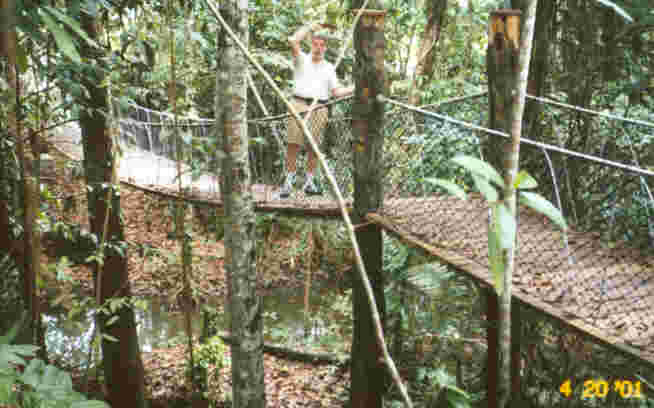 The hotel tennis courts are nice -- but right next to the river's edge. Hot for the players. We found a rope bridge across a small creek and I took snapshots. Also, we saw beach volley ball courts, a "street basketball" court and a "bocca ball" (sic) covered shed. The hotel tennis courts are nice -- but right next to the river's edge. Hot for the players. We found a rope bridge across a small creek and I took snapshots. Also, we saw beach volley ball courts, a "street basketball" court and a "bocca ball" (sic) covered shed.The hotel has three pools. One is sort of a pool with two wings, one of which has a slight wave action. The other pool was not used when we looked it over -- it was set up for a show Saturday night. When it came time to board the Santana III, our bags were taken from the hotel lobby to the boat -- thank heavens! All we had to do was descend the stepped walkway from the hotel entrance down to the dock. (It was the heat of the day: 2:30 p.m.) The yacht was immaculate when we boarded. Three deck levels (counting the upper observation deck), with the lounge (Saloon) on the middle deck behind the wheelhouse. (Interesting set of alternating polished wooden steps to climb to this level.) Our cabins are on the same level as the galley and the mess. We were offered punch drinks nearly as soon as we boarded...I felt like a Sultan! Our main guide is Juscelino ("call me 'Joe'"), a youthful looking young man with an accent -- but not too difficult to understand. Fred surmised that he is on board just to talk to us in his (broken) English, but I don't agree. He is not -- by any means -- fluent with his English explanations (and he had a difficult time remembering the word "vine"). What a delight to have a private stateroom (about 6 and a half feet square) and a private bath. I don't know how we would have managed if we both had been in one stateroom with its tiered bunks and blessed air conditioning. Fred's cabin is forward of my stateroom, and the type of key to our quarters reminds me of the front porch door at the cottage. I had a single mosquito in my stateroom, bunk cubicle and bath cubicle each, both nights we slept on the yacht. There is a narrow upper window in the bathroom (with shower, no less), which I closed as soon as we were underway. (Did the wily mosquitoes enter through this passageway?) I propped the bathroom door open for the night (no AC in the head) by placing the hook for the door on the canvas snap-on covering behind the window on the stateroom door. To open the coverings on the stateroom window and door, each must be unfastened from a number of snap-fasteners. I noticed that the crew left the canvas hanging from the lower row of fasteners on the Saloon windows. The lower level bunk in the stateroom is wide, making the upper level bunk a perfect surface for placing baggage and other stuff, as there's virtually no room on top of the little bunkside cabinet. In the narrow bathroom, I found it best to put my dopp kit on top of the toilet -- except when using it, of course. Tables in the spacious mess room (with corner wash basin) included place settings for only seven persons, although the brochure states that there are accommodations for 16. The steward (always so anxious to please us, but completely non-conversational in English) offered us olives on toothpicks and pastries almost as soon as we were underway. What luxury! The breeze on the river is delicious, once we have reached cruising speed. The views of Manaus, the resort towers (at Ponta Negro, west of downtown), and the port and commercial facilities of the metropolitan area (including a refinery east of the city) are excellent from the upper deck of the craft. The confluence of the Negro (warm) and Amazon (cold) rivers is disappointing. Yes, you can see a definite demarcation between the two waters, but it is jagged, splotched, and often covered by floating leaf "islands" or other natural debris. The engine on the yacht slowed considerably before we reached the confluence, which was explained to us as necessary because of the strong difference in temperature between the warm Negro and the cold Amazon. The sharp contrast would be too much for our yacht's water-cooled engine to manage at regular speed. A rusted freighter anchored in the Negro had been there for two months with "motor" trouble, says Joe. (I'd hate to be the owner of that ship, lying at anchor all that time without cargo or crew.) When we turned back on the Negro (what a wide expanse of water!), evening already was descending upon the scene. Before dinner, we ventured out in the "motorized canoes" carried on drag lines from the yacht's stern. (They're really oversized rowboats with built-in flotation beneath the seats athwart the gunwales.) When the ship stopped at a little souvenir shoppe along the river bank, we set out to investigate some of the humongous lily pads in an estuary of the river. Soon, from a far bank, a sallow-faced Amazonas youngster paddled like mad (from the bow of her dugout) to where we were drifting among the pads. As soon as she was alongside our drifting craft, she reached behind her and brought out a live cayman (about 14-16 in. long). She wanted us to buy it, as her other hand tentatively reached out, palm up, for recompense. I thought the animal was unfettered, but Fred noticed its jaws were laced tight with string. No matter, it sure looked like a crocodile, belly skin and all. Joe slipped the girl a bill for her efforts -- but we didn't accept the cayman. 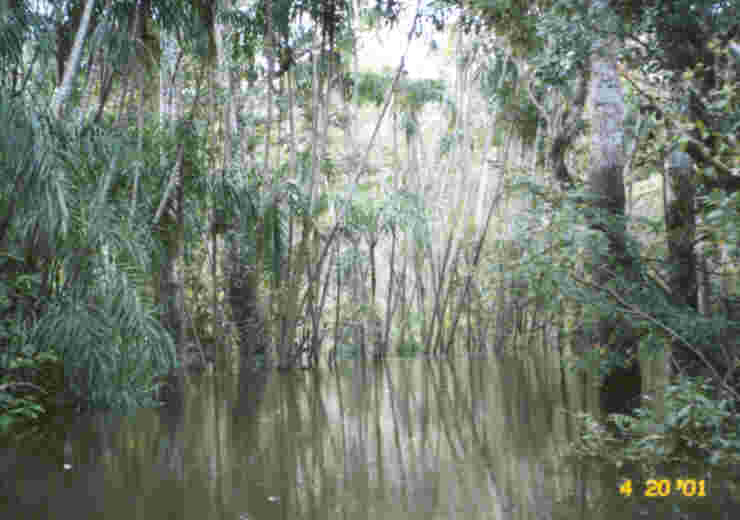 When Joe climbed out of the boat to reach some rare "inga" fruit up a tree in a quiet tributary, I was more concerned with the stability of the rowboat than the piece of bark that nearly crowned Fred as it fell from the tree. Within an instant, however, the boat, our clothes, everything was swarming with ants. Little black ones, over a quarter-inch long, that were frenzied. Within an instant, so were we (frenzied)! Joe had dislodged this colony of hundreds -- maybe thousands -- of ants...and they all were swarming our boat. I looked at Fred: he was a standing anthill. They even were on his hat -- and neck, and arms, and shirt, and pants, and camera, and shoes, and probably crawling inside our clothes. "Don't worry, they don't bite" was Joe's exclamation within a second or two of the first bites felt by Fred and me. We felt them on our faces, in our ears, between our fingers, in our hair. I seriously considered jumping in the water. What a blessing to see a built-up landing just a few yards away. When Joe climbed out of the boat to reach some rare "inga" fruit up a tree in a quiet tributary, I was more concerned with the stability of the rowboat than the piece of bark that nearly crowned Fred as it fell from the tree. Within an instant, however, the boat, our clothes, everything was swarming with ants. Little black ones, over a quarter-inch long, that were frenzied. Within an instant, so were we (frenzied)! Joe had dislodged this colony of hundreds -- maybe thousands -- of ants...and they all were swarming our boat. I looked at Fred: he was a standing anthill. They even were on his hat -- and neck, and arms, and shirt, and pants, and camera, and shoes, and probably crawling inside our clothes. "Don't worry, they don't bite" was Joe's exclamation within a second or two of the first bites felt by Fred and me. We felt them on our faces, in our ears, between our fingers, in our hair. I seriously considered jumping in the water. What a blessing to see a built-up landing just a few yards away.When we brushed off the ants on the dock, which served as the front porch to an Amazonian's hut on the river, I was able to direct the concern about my own discomfort long enough to pity the poor homeowner, on whose quiet little cottage we had just foisted about ten thousand ants. (But only for a fraction of a minute.) We were being whipped by the shirts of the guides, who were trying to brush off the aimless, scurrying ants. Even when most of the ants had been brushed, stomped, slapped, kicked or otherwise flushed from our bodies and our immediate presence, it seemed as though they stayed with us for the rest of the night. There were plenty of them in the boat as it sped back to the yacht. (I envisioned them taking over the entire Santana III, forcing us all to abandon ship as they raced into the food, the drinks, the gangways, the sofas, etc.) Fortunately, I think we took leave of them as we boarded the yacht at the stern. I found none on my clothes -- or my skin! -- after leaping from the rowboat back aboard the yacht. Dinner aboard the yacht was buffet style, dutifully attended by the steward, who was painfully anxious to please us. (He poured so many "Light" Cokes for me, I feared I'd have them in my bloodstream for the next six months. While we ate...and, later, while we cruised up the river...the weather was warm, the saloon windows were open (without many bugs)...and the twinkling of lights ashore became more and more scarce. How the skipper navigated up the river to the "Three Mouths" is beyond me. Yes, I noted he often beamed his searchlight ashore, but the proliferation of river branches, estuaries, lagoons, etc. seemed endless to me as a passenger. Thank goodness for the GPS and charts! After all, the Negro is 1,400 miles long. With enough fuel, we could have cruised forever! Actually, we had reached the Anavilhanas -- a proliferation of islands, estuaries, lagoons, river branches and other waterways involving hundreds of rainforest islets and peninsulas. The air conditioning in the stateroom is a blessing! What a contrast in the temperature: outside, warm and humid; inside, comfortably cool. (I used the blanket for sleeping.) My stateroom door window revealed condensation on the lower third. Joe explained our plan for Saturday morning: wake-up call at 5:00...gulp of juice...then to the boats for an excursion at dawn. He did it matter-of-factly, as though there was no other choice. Well, it sounded good, anyway. A warm, gray dawn accosted me as I opened my stateroom door, following Joe's gentle knock. (He admitted it was around 5:30.) The water in the little bay where we anchored was glassy calm, as we took to the boats. Within a short put-a-put up the river in the direct-drive aluminum boats, we suddenly turned in. I thought we'd go a few yards and then just ingest the atmosphere of the igapo (the buried-under-the-water state of the rain forest floor). Instead, we just kept on going through a fastasyland: mirror-smooth water merging in misted settings with forest foliage, hanging moss or vines, floating (living) leaf islands, monkeys in the tallest branches of the trees...and everything silently standing in 20+ feet of Negro river water. What great fortune Fred and I enjoyed, being positioned in the first seat of the boat. We had a view better than everyone else. My meager snapshots did not do justice to the surrealistic impressions we experienced of the jungle under water. At a hut along the river (after breakfast), we stopped at a shed where a native was stirring grain in a 4-ft. diameter concave "bowl, heated by a fire burning below. The contents of the bowl, we were told, was a yellow-tinted flour called "ksava." After being picked in the forest, squeeze-dried and dumped in the pot, the stuff is cooked and stirred (with a paddle) for four hours (that's a lot of paddling!). If this procedure isn't followed, the flour is poisonous! And we ingested a lot of it on salads, noodles, rice, etc. during our meals aboard the Santana III. When we stopped at a wobbly dock along the river's edge, we left the aluminum boats and stood before a hill. Then, we started up a make-shift path (it reminded me of a neglected stepping-path up a steep dune at Lake Michigan.) And we kept climbing...and climbing...and climbing. We must have climbed a hundred steps or more before we emerged into a small village -- built around a soccer field: a few shacks, the inevitable display of crafts, and lots of kids. The climb winded me, but the view of an Amazon Indian community was worth the exertion. There was evidence of some electrical lines (a generator provides the power, we were told), and a few manufactured items in the shacks, but otherwise this was pure primitive living. Outhouses behind the dwellings contained nothing more than a hole in the ground, according to our guide. Our trek in the jungle was guided by a native of the rain forest, who spoke only Brazilian. So, the only information we gleaned from his explanations was "translated" by Juscelino--also in broken English. Make no mistake, the jungle is hot. And, away from the water, there are mosquitoes...and ants, and spiders, and birds, and many other bugs -- on, in and around the plant life. It turns out that the rain forest is friendly, if you know what you're doing -- or you live there, as does our guide. Many plants provide fruits to eat, vines provide water to drink, and trees provide sap or latex or other fluids for a variety of uses. The rule is: if other animals eat the vegetation, it's okay for human consumption. If animals don't touch it, it's poisonous. Walking in the rain forest does work up a sweat. In fact, my shirt soon was soaked with sweat. Thankfully, our muddy boots were cleaned by the boat personnel, after we returned. Actually, the yacht had pulled in to a small single-plank dock, just below the forest guide's stilted cottage (he actually lives there!). We got a yacht ride back to a convenient anchorage for lunch. Now I know how the rain forest gets its name. When we saw a curtain of rain heading our way, I knew it was going to be a drencher. It was. And it lasted. Even when we ventured out later, I knew it wouldn't quit. And it didn't. We came scurrying back in our aluminum boat with the rain pelting us in the face. The perfect situation for a snooze on the white leather couches in the saloon, on which we slouched, forthwith. Joe wanted the rain to let up so we could go Piranha fishing later, but the intensity of the rain intimated that it would be more than a passing shower. And Joe admitted that heavy showers could induce the Negro (Joe called it the "Black River") river to rise as much as 2-4 inches in a short time. Searching for caymans from the yacht, after an early, damp dusk, was elucidating. When the searchlight is played along the shore, two red spots -- like bike reflectors -- betray the eyes of a crocodile. We saw many, and one was caught by the boaters in the dark -- the same stupid creature caught earlier and proudly displayed to all during our dinner aboard the Santana III. The dawn is soft and fuzzy. After yesterday's rain, the boat is damp and bug-cluttered. Enough insect carcasses to require washing down with a hose. But the tributary (one of hundreds) where we anchored was quiet and peaceful. Birds glided above the craft, and the narrow shorelines were blurred by the mist. As we made our way back east, it was amazing to see that so many of the shores I presumed might be the south bank of the river were merely limits of an island in the Negro...perhaps even a peninsula of rain forest inundated with igapo. And an occasional fisherman was noted from the deck of the boat. One, I spotted within the igapo pulling in a net (for piranha?...no, probably tambaqui.). 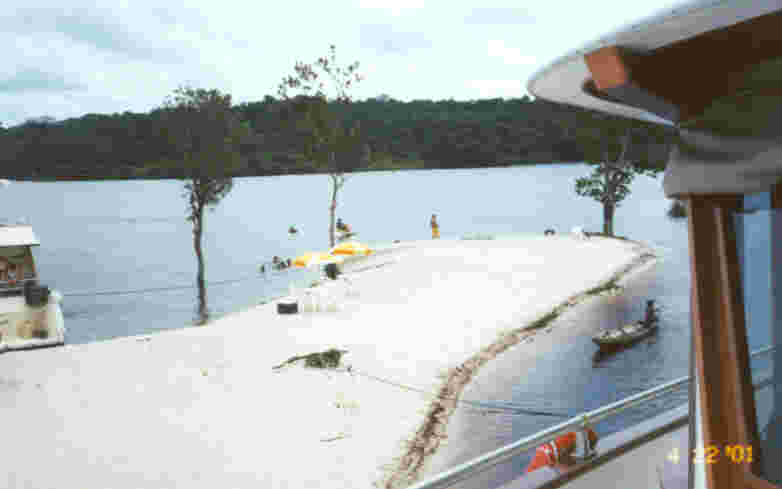 The brochure had said Sunday would be spent swimming off Ponta Negro. It was wrong. We went swimming in the Negro off a sandy spit of land almost beyond eyesight of Manaus -- many miles west of the city, I presume. Obviously, this was a beach area for many of the locals. Boats of all sorts were beached on the side opposite the sand spit to the river itself. A boat was required to reach the main beach area, where barbecue pits, picnic tables and other paraphernalia were in evidence. During this high-water period, the whole area here -- and well inland, according to a brief boat ride, courtesy of Joe -- becomes a resort-like scene: cottage type dwellings along the shore...boats moored in front of shacks, or even improved houses dotting the shoreline...many smaller boats--some speedboats -- purring through the lagoon. The brochure had said Sunday would be spent swimming off Ponta Negro. It was wrong. We went swimming in the Negro off a sandy spit of land almost beyond eyesight of Manaus -- many miles west of the city, I presume. Obviously, this was a beach area for many of the locals. Boats of all sorts were beached on the side opposite the sand spit to the river itself. A boat was required to reach the main beach area, where barbecue pits, picnic tables and other paraphernalia were in evidence. During this high-water period, the whole area here -- and well inland, according to a brief boat ride, courtesy of Joe -- becomes a resort-like scene: cottage type dwellings along the shore...boats moored in front of shacks, or even improved houses dotting the shoreline...many smaller boats--some speedboats -- purring through the lagoon.The nature of the boats beached on the sandy spit is worthy of mention. Some looked barely seaworthy. Many were decrepit, packet-like vessels, with rusting inboard motors, clothing strewn around the benches/tables/folding chairs on board, and wobbly, single-board gangplanks from sand to gunwale. Yet, there was another "luxury" cruise ship just 50 yards from where our yacht was beached...another very-modern-looking luxury yacht entered the basin...and the people appeared to be of mixed backgrounds. Perhaps it was the same commingling you'd find at the Oval beach on Lake Michigan or the beach at Boca Raton. The beach area was very popular. On our way out, and back, I noted a number of ferry-like vessels heading for the beach -- all loaded with Sunday afternoon passengers seeking leisure-time pleasures. The water was warm -- warmer than it ever gets in front of the family cottage at Lake Michigan. But, even though we had been told of its high acidity, it appeared to be relatively clear, and free of creatures vying with the waders and swimmers for "space." My brother, Fred, wanted to swim across the lagoon, from the beach to the yacht. I demurred, but he was intent on doing it, so I felt comfortable to accompany him in the aluminum boat with Joe steering the outboard motor. My swim was just around the yacht. As we motored in our luxury yacht back toward Manaus, I thought we would encounter more rain, but we experienced nothing more than a light sprinkle for just a few minutes aboard the Santana III. Since we had to drop Juscelino off at the Santana's home dock (to pick up his car, we were told) we had a chance to view another aspect of western Manaus: a waterfront with pleasure craft, numerous moorings and floating docks for boats of all kinds, some fishing vessels and the governor's mansion. Yes, mansion. According to Joe, it is valued at something around four million dollars and has a private, covered walkway to his 40-foot yacht. (Apparently, it pays to be a political bigwig in Brazil. Joe says the governorship virtually has been in the same family for decades.) What a hoot we had trying to get our bathing suits, etc. dry in the hotel after out yachting trip was over. We exercised the hair dryer in the bathroom to the point that it overheated. This was preferable, however, to paying a fortune to the hotel for performing the same task. Sleep ashore, after a mere two days on the water, was delicious. But, to me, the hotel was bobbing on the water. At least, it felt that way during and before my sleep that night. A small price to pay for such an awesome trip! 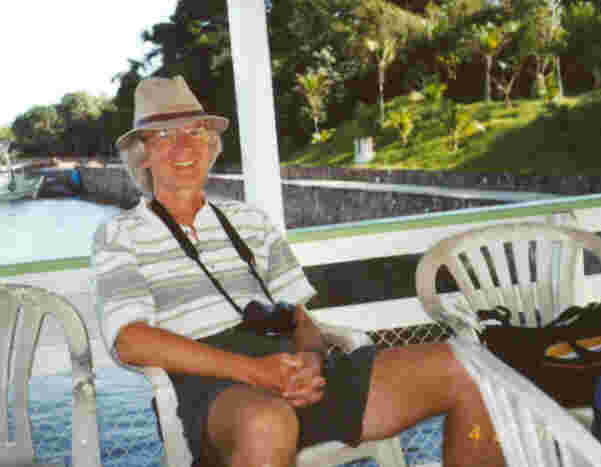 We needed a wake-up call to be sure we'd be ready for the boat ride to the Ariau Towers, because we wanted to be sure to get some breakfast before leaving. It was the same sequence as before: a recorded message 15 minutes before a live voice told us it was 6:30 a.m. The dining room opens at 7:00, and we wanted to be ready. After all, our packet boat to the Towers was due to leave around 8:00. We needed a wake-up call to be sure we'd be ready for the boat ride to the Ariau Towers, because we wanted to be sure to get some breakfast before leaving. It was the same sequence as before: a recorded message 15 minutes before a live voice told us it was 6:30 a.m. The dining room opens at 7:00, and we wanted to be ready. After all, our packet boat to the Towers was due to leave around 8:00.The ferry boat to take us to the Towers looked top heavy. And, of course, that's where all the passengers congregated. (Luggage was stored on the lower deck, flung on a table abaft of the motor housing.). Below, many of the workers (?) at the Towers were lounging on chairs, the deck floor, wherever--most of them catching some shuteye as we slowly made our way to Ariau. Above, populating nearly all of the covered area of the deck, were the Elder Hostel folks again. A guide explained some of the features of the area to them, in broken English, as we plodded east through the Negro's choppy waters toward the Towers. 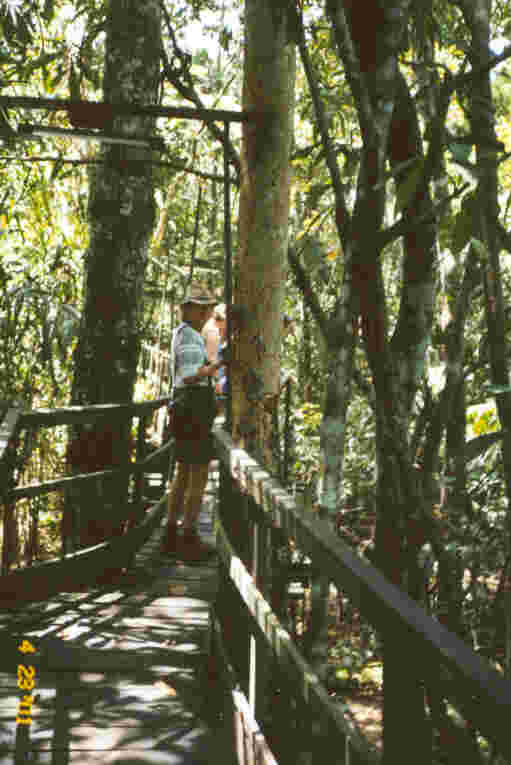 When we had seen the Towers community from the Santana III, returning from our Negro excursion, the building most prominent in my binoculars seemed to be the one featured in the promotion folders. Turns out, it was not an older building. It was a new one under construction. It was the first one we saw -- in the distance -- as our packet boat chugged toward the settlement. When we had seen the Towers community from the Santana III, returning from our Negro excursion, the building most prominent in my binoculars seemed to be the one featured in the promotion folders. Turns out, it was not an older building. It was a new one under construction. It was the first one we saw -- in the distance -- as our packet boat chugged toward the settlement.Disembarking at the Towers, my first impression was that the entire complex was built on pilings above the water. We had seen a helicopter pad from the Negro, several lengthy catwalks, and some rounded buildings. As it turns out, nearly all the buildings at the Ariau Jungle Towers are rotunda-like structures. The reception building, for instance, is round, four stories high. The main desk is on the lower level; our dining area on the second floor; an auditorium-like room on the floor above, and a nightclub-like room at the top. We had to climb the stairs to our meals each day, and the door was guarded (from monkeys) by an attendant. Another early impression of the Towers: there are monkeys in abundance. Although the first sign I read (after all the Towers ID signs -- including its website) referred to the monkeys, it was one of many that provided directions, identified buildings and reminded us about feeding the monkeys and the birds. The sign read something like: "IS NOT TO FEED THE MONKEYS DRINKS, AS THIS IS DANGEROUS..." Many of the boardwalks connecting the buildings at the Towers are covered, which is a good thing, as the rains are often frequent, heavy, and would discourage trips like going to eat, shopping, heading for the dock, etc.  Our first lodging was on the main floor of one of those round, multi-floored buildings. We had some time before our orientation tour to check in, enter the room, open the window for air (there was none stirring), recognize we had no cross-draft, find that the atmosphere was stifling, and decided that we had to have air-conditioning. Just sitting there, in that small wedge of a room -- our second choice, actually, the first one revealed a double bed only -- was enough to bring out the sweat and make us gasp for fresh air. Our first lodging was on the main floor of one of those round, multi-floored buildings. We had some time before our orientation tour to check in, enter the room, open the window for air (there was none stirring), recognize we had no cross-draft, find that the atmosphere was stifling, and decided that we had to have air-conditioning. Just sitting there, in that small wedge of a room -- our second choice, actually, the first one revealed a double bed only -- was enough to bring out the sweat and make us gasp for fresh air.Our tour of the complex, which we had been told was initiated by famed explorer Jacques Cousteau, took us to a number of rounded buildings (all with doors to keep out the monkeys), a section with cages for birds and animals, many catwalks (some two-tiered), another helipad, a UFO pad (c'mon folks, let's get serious) and a meditation pyramid. At the latter, we were asked to remove our shoes, enter the air-conditioned pyramid (air conditioned?) and lie down on rugs to contemplate the world. That was restful, but hardly elucidating. My brother couldn't even abide the lying down part. He took a few seconds of video and fled the place. 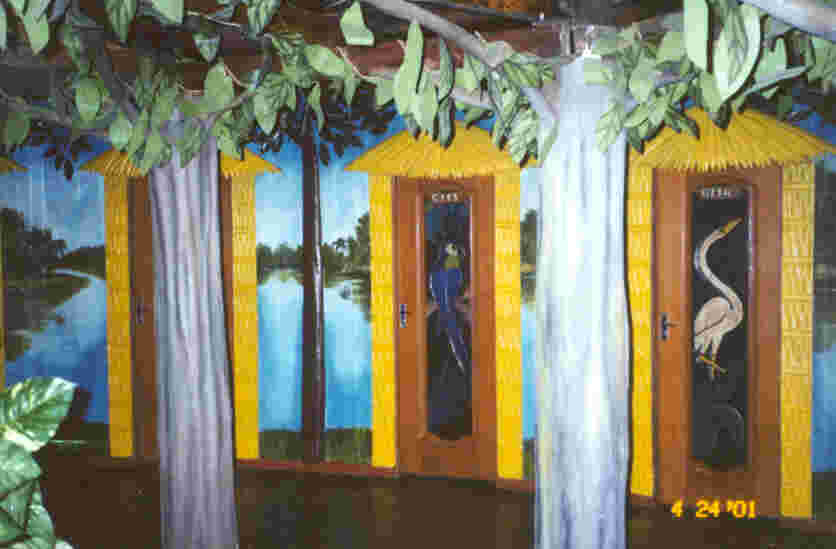 Meals were all buffet-style, with the food centered in the round hall where we ate at long mess tables flanked by benches. Instead of taking a chance on the water (ice cubes also were offered), I stuck with "Light Coke." I was so consistent with this, that -- beginning the second meal -- a waiter automatically brought me a Coke or two. Meals were all buffet-style, with the food centered in the round hall where we ate at long mess tables flanked by benches. Instead of taking a chance on the water (ice cubes also were offered), I stuck with "Light Coke." I was so consistent with this, that -- beginning the second meal -- a waiter automatically brought me a Coke or two.On our first excursion from the Towers in the mid-afternoon, we settled in a long rowboat (eight seats athwart the gunwales) with a long-shaft direct-drive outboard motor for propulsion. We started out to the east on the Ariau River (directly behind the peninsula on which the Towers complex is located) and learned that the jungle under water is called the igapo. Alan, our guide (seated at our meal, he looked East Indian; out on the river, he looked much more Amazonian), provided us an intelligent commentary on the flora and fauna. At one point, we left the river to enter the igapo, and caught up with a longer boat replete with chattering Elder Hotel folk. Alan had no patience with them. First we moved beyond them, to get away and listen to the sounds of the jungle in quiet; then, we let them pass us -- for the same reason. Finally, Alan gave up and we motored by them once more and out, eventually, into the Negro. It was here that we experienced a true, multi-hued Amazonian sunset. It was spectacular. 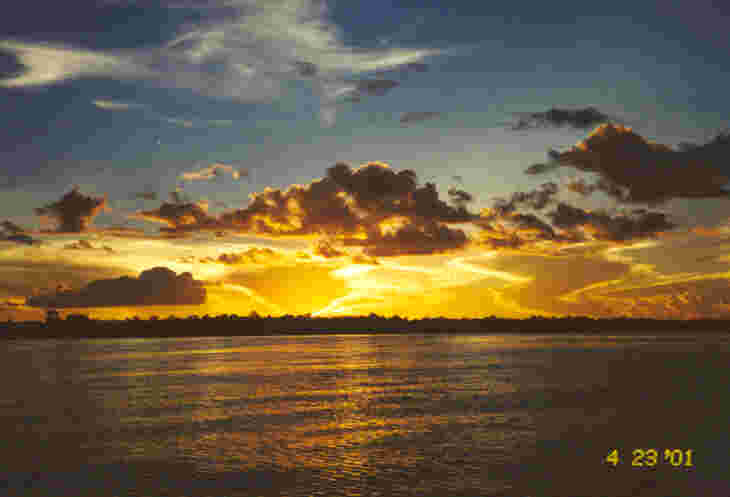 I was disappointed I hadn't taken my camera along when we took to the boat again after dinner to hunt for caymans. The same people were along, including Gerry and Sue Cooper from London, England, and Jonas, an apprentice (with a degree in Environmental Science) who boarded our boat on the Ariaú during the afternoon. The reason I was disappointed: we caught a cayman. It happened after we went through the routine of shining a spotlight along the shores of a marshy area, looking for those two red reflector lights. When one was spotted, just swimming under the boat, the guide on the bow jumped in the water! What a sight: first, the head of a cayman emerged...then a hand holding the cayman around the neck...and finally, the head of the guide, surfacing above the water amongst the weeds and leaves congregating along the shoreline. The cayman was over a meter long -- a female, it was carefully established, and once, when someone went to stroke its belly, it writhed abruptly and almost shook loose. (It was headed for my brother, who straddled the seat...that would not have been a pretty picture!) I was disappointed I hadn't taken my camera along when we took to the boat again after dinner to hunt for caymans. The same people were along, including Gerry and Sue Cooper from London, England, and Jonas, an apprentice (with a degree in Environmental Science) who boarded our boat on the Ariaú during the afternoon. The reason I was disappointed: we caught a cayman. It happened after we went through the routine of shining a spotlight along the shores of a marshy area, looking for those two red reflector lights. When one was spotted, just swimming under the boat, the guide on the bow jumped in the water! What a sight: first, the head of a cayman emerged...then a hand holding the cayman around the neck...and finally, the head of the guide, surfacing above the water amongst the weeds and leaves congregating along the shoreline. The cayman was over a meter long -- a female, it was carefully established, and once, when someone went to stroke its belly, it writhed abruptly and almost shook loose. (It was headed for my brother, who straddled the seat...that would not have been a pretty picture!)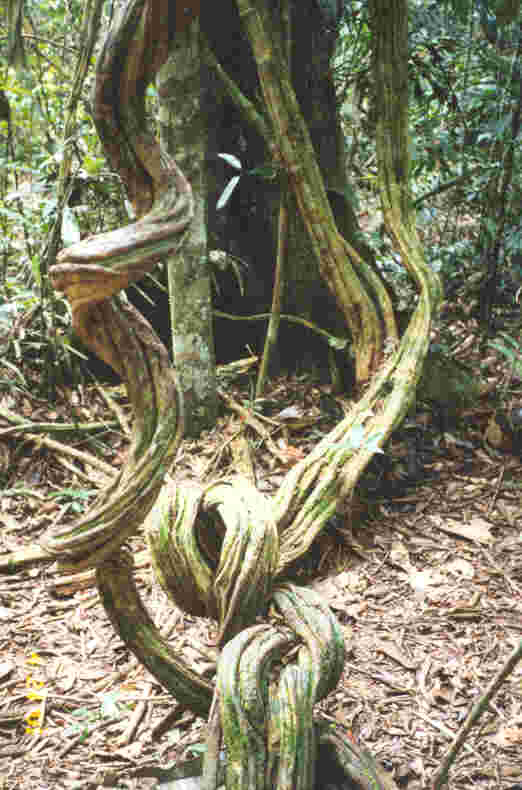 A cool shower (no hot water) the night before was enough to wash away the perspiration of the previous day. This day we were in store for another walk in the jungle. And this time, we heard in better English (not perfect, by any means) some of the lore of the jungle -- including some of the same things we had learned on the Santana III expedition. One of the highlights of this trip was when Jonas was given a little white grub, which we found to be curled up within a Brazil nut taken from one of the trees, and he plopped it in his mouth and chewed it! "Tastes milky," he observed. A cool shower (no hot water) the night before was enough to wash away the perspiration of the previous day. This day we were in store for another walk in the jungle. And this time, we heard in better English (not perfect, by any means) some of the lore of the jungle -- including some of the same things we had learned on the Santana III expedition. One of the highlights of this trip was when Jonas was given a little white grub, which we found to be curled up within a Brazil nut taken from one of the trees, and he plopped it in his mouth and chewed it! "Tastes milky," he observed.At the landing where we entered, and exited, the jungle, were a couple of huts with thatched roofs. That was interesting, because we had a lesson in how they prepare the palm leaves for roofs during our sojourn in the jungle. Sure enough, upon inspection, the roofs were layered just as had been described. One of the the buildings, of course, had tables of artifacts and native-fashioned trinkets. One of them, a crown of palm leaves, was given to me, and I also came away with a grasshopper (locust?) crafted of palm leaves. The latter survived the trip home in a suitcase. The crown was left behind at the Towers. 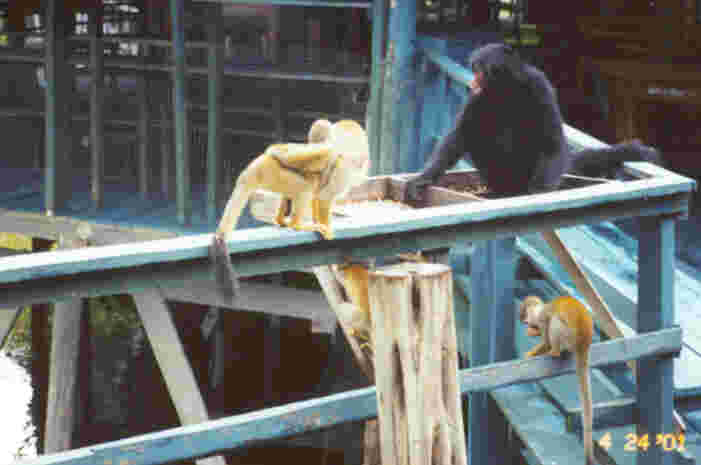 Shortly after our midday meal, we had another rain shower, a heavy one, accompanied by thunder and lightning. The skies still were threatening when it came time to go piranha fishing. Alan was late to arrive at the dock for fishing, and his first comment was something like "We won't catch any fish today [as a result of the downpour and threat of more rain]." That was enough for me. I don't like fishing anyway, and I dislike not catching any fish even more. So, I opted to stay while the others went off in search of those ugly fish with the sharp teeth. As it turned out, they did not get soaked in the rain, but I got some good shots of the monkeys playing around some of the feeding troughs positioned just off the railings along the main walkways. Shortly after our midday meal, we had another rain shower, a heavy one, accompanied by thunder and lightning. The skies still were threatening when it came time to go piranha fishing. Alan was late to arrive at the dock for fishing, and his first comment was something like "We won't catch any fish today [as a result of the downpour and threat of more rain]." That was enough for me. I don't like fishing anyway, and I dislike not catching any fish even more. So, I opted to stay while the others went off in search of those ugly fish with the sharp teeth. As it turned out, they did not get soaked in the rain, but I got some good shots of the monkeys playing around some of the feeding troughs positioned just off the railings along the main walkways.A couple of drinks at the crude bar along the main boardwalk was a nice way to end the day before dinner. The Coopers picked up the tab, and it was pleasant to have gin-and-tonics before our meal. The wake-up call this morning was for around 5:00 -- so we could experience an Amazonian sunrise on the Negro. This we did, but only after leaving the dock late, as our boat (No. 8) was stuck in the reeds and grass back in the canal that winds through the Towers complex. Another had to be commandeered, which required a trip through the catwalks back into the canal. The sunrise, however, did not have the drama of the sunset, except for the sounds from the jungle, which we experienced adrift on the Negro. Birds (Macaws?) and howler monkeys were the prime sources of sounds, but as they receded, we noticed storm clouds gathering to the north and east. Were they coming our way? Not long after we bade farewell to the Coopers on the packet ship, we were back in our No. 8 craft heading west on the Ariau River with another couple in the boat. (This couple, with whom we also had several meals, was French, and had been teaching in São Paulo. This might be their farewell to Brazil, as their contract was due to terminate in a couple of months.) Our destination on this last trip was a village, which had been built up around a mission church at a community called Acajatuba. It was along the way to this visitation that my brother discovered he was not alone around the ankle of his right leg. Upon pulling his socks down, he discovered a colony of little black specs -- they looked like minute gains of sand to me -- which turned out to be ticks. Our guide, Alan, referred to them as carrapato ants, but later examination determined them actually to be ticks -- all intent on sucking my brother's blood for a filling meal. [As an aside, some of these little critters stayed with him for several days, even though he spent most of the boat ride to the village picking them off, and then spent a substantial time in the evening in our hotel room, searching for them on all body parts -- nooks, crannies and orifices. I even helped in the search on the backside, out of his view. They were so small, it was difficult to see them, let along pick them off and drown them, which was his procedure during our launch ride to and from the native settlement.] The village was built around a soccer field (of course) with the church a central facility, near the water's edge and close to a dock (presumably where the parishioners along with tributary arrived to attend services). The church was (temporarily) without a priest, but an examination through the windows showed an orderly looking interior, well kept and well furnished. School was in session at one of the shacks, and we found out later it ends about 10:30 in the morning. (Probably starts early, to avoid the heat of the day.) A number of youngsters were encountered on the paths around the dwellings, some of the youths carrying books in their arms or in backpacks. Among the buildings in the community was another shed for cooking flour, only this time it was called "majork" by Alan. A walkway over the water took us to the village sculptor, whose path and entrance were graced with examples of his trade. There was the inevitable souvenir shop, of course, and another ramshackle building had a sign reading "FAST FOOD" - -meaningless in that village, but obviously picked up from the "Yanquis." Alan told us that some of the dwellers there were fishermen, still others raised some crops. We took an alternate route back to the Towers, passing by a number of stilted buildings along the shore -- some of them resorts, according to Alan. These actually looked sharper than most of the structures at the Towers, but, then, Jacques Cousteau didn't found any of them. 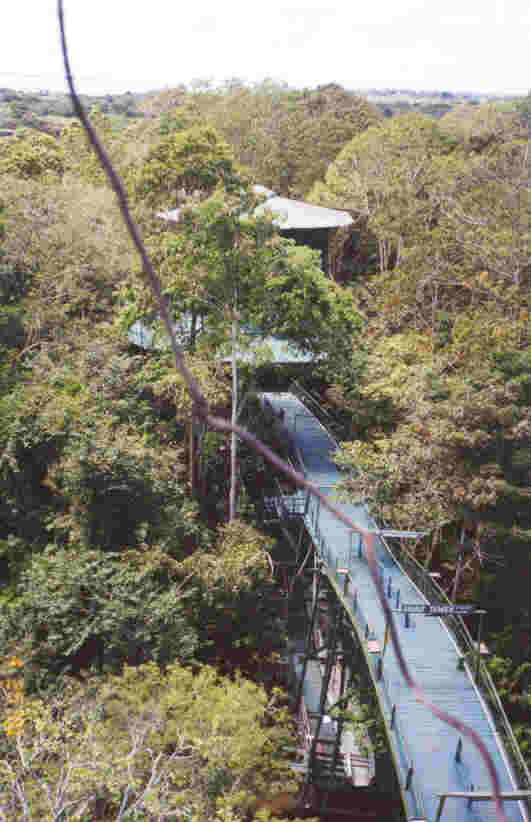 Back at the Towers, after one final whoosh through the reeds and living flotsam (this was a constant, throughout the trip: attempting to get through the surface plants and leaves that often blocked the routes in, out or through the waterways picked by our guides), we disembarked at the dock on the Ariau River side of the complex. It also was the location of the observation tower for the community above the waters. So, we climbed the tower and took some shots of both rivers (north and south, east and west). On the walkway back
we saw our first snake (other than the boa we held at one of the shops at the Towers), a green one, about three feet in length. Back at the Towers, after one final whoosh through the reeds and living flotsam (this was a constant, throughout the trip: attempting to get through the surface plants and leaves that often blocked the routes in, out or through the waterways picked by our guides), we disembarked at the dock on the Ariau River side of the complex. It also was the location of the observation tower for the community above the waters. So, we climbed the tower and took some shots of both rivers (north and south, east and west). On the walkway back
we saw our first snake (other than the boa we held at one of the shops at the Towers), a green one, about three feet in length.We also examined the Towers' aviary, and I had an encounter with a clinging monkey, who rode on my leg for 10 or 15 yards before it became evident I wasn't going to feed him and he scampered off. The ferry boat ride back to the dock at the Tropical Manaus hotel included -- of course -- the Elder Hostel gang. Jonas, the apprentice guide, spent some of the time sitting/lying/stretching on the counter at the back of the upper deck. On this trip, too, we saw menacing clouds ahead. A rainstorm was forming -- it appeared -- right in our path. It was interesting watching it rake the peninsulas of land with sprays of water...but it never touched our chugging craft. Sunrises and sunsets, alike, occur quickly a few degrees from the equator. We noticed a rich, yellow-orange sky from the hotel, and went out from the shops where we had purchased indigenous masks to record it on film. By the time we reached the water's edge, most of the bright color had faded. But, a couple of my photos turned out okay, as taken through the palm fronds, so it wasn't a wasted attempt. Whoever heard of catching a scheduled airplane at 4:00 a.m.--especially when you are warned to be at the airport two hours before departure? Well, there were others in the same situation, and we dutifully waited in line at Manaus International for our flight to be called. A conclusion, bolstered by observations at the airport, in the hotel around the city of Manaus, even in the Amazonas wilderness: the women of interior Brazil are either very striking, or very plain. There seems to be no in-between. Some very attractive females were noticed at the airport, but others were, well, quite the opposite of attractive. My own opinion, only. Just for the record, I spent a total of 21½ hours door-to-door on my return trip. That includes getting up at 1:30 a.m. at the Tropical Manaus; a flight to Belem, Brazil, for an hour's layover; a flight to Miami; waiting for my flight to Chicago, which was delayed first for a thundershower, and later because the baggage handling crew was "changing shifts; a delay at Chicago's O'Hare Airport (the wrong gate was posted, among other things); and, finally, a late touch-down in Grand Rapids, as we skirted thunder storms over the lake and over Michigan. My brother's encounter with the ticks had me checking the entire landscape of my own skin for several days after my return. I haven't found a critter yet, but the thought of all those miniature creatures populating his body makes me want to check mine over, once and again, just to be "sure." My photos, nearly 150 of them, turned out to be quite acceptable. Not all of them are good (some are downright useless), and -- upon reflection -- I missed getting some highlights on film (the ant invasion, Fred's piranha catch, a pair of red cayman eyes reflecting in the light, a pair of beautiful parrot-like birds that visited the Towers just after he embarked to go fishing -- but which took off from the catwalk railing before I could get my camera out of its pouch, the wall of rain approaching the Santana III). But, a good record, anyway. Whoever heard of an eight-day vacation trip out of the country going perfectly smoothly? This one had a few bumps, but many more highlights and delights. Before this year, I had never even dreamed of taking a trip to South America, and Amazonas was far from my wildest dreams. Now, the Amazon region is in my dreams--and, with a couple of exceptions (one of them populated with ants) -- they are deeply gratifying ones. I can't thank my brother enough, or in the appropriate words, to express my heartfelt appreciation, bolstered by pleasant, stimulating, edifying, intriguing and gratifying memories and experiences. Amazonas is another world. Full of natural phenomena, full of interesting creatures (civilized and otherwise) and full of lifetime impressions for me. |